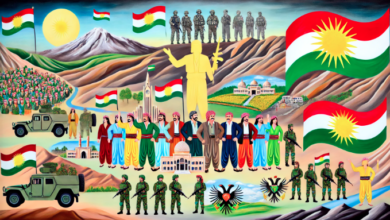Syria: A Battlefield of Regional and International Powers
Syria has become one of the most complex conflict zones in the world, where global and regional interests clash in a multi-layered struggle. Since the Syrian uprising in 2011, the country has evolved into a proxy war theater, with shifting alliances and competing agendas. Recent military operations in regions like Aleppo and Deir ez-Zor highlight ongoing efforts to reshape power dynamics and reduce the influence of factions aligned with specific foreign powers—particularly Iran.
Targeting Iranian Militias: Context and Objectives
Iran has been a major actor in the Syrian conflict, providing military and logistical support to the Assad regime through a network of allied militias. However, recent developments suggest an emerging consensus among international and regional players to weaken Iran’s foothold in Syria. Current military actions by various groups—including ISIS, Hay’at Tahrir al-Sham (HTS), and possibly the Syrian Democratic Forces (SDF)—may serve this broader strategy.
These groups, despite ideological differences, appear to function as tools in a larger geopolitical game. Turkey’s backing of certain factions and the U.S. support for the SDF reflect coordinated efforts to limit Iranian presence, especially in strategic areas like Deir ez-Zor.
Iraq’s Popular Mobilization Forces (PMF): Shielding Iran’s Interests
The mobilization of Iraq’s Popular Mobilization Forces (PMF) aligns with their role as a strategic extension of Iranian influence. Any threats to Iran’s presence in Syria could destabilize its broader regional strategy, including in Iraq. This explains the PMF’s heightened readiness, as it seeks to safeguard Iranian interests, potentially through direct or indirect interventions in Syria.
Russia’s Calculated Role
Russia’s involvement in Syria remains pivotal. With its ongoing war in Ukraine and mounting pressure from the West, Moscow relies on Tehran’s military support, particularly in the form of drones and other equipment. In return, Russia may act to protect Iranian interests in Syria, recognizing the critical importance of this partnership for its broader geopolitical objectives. A weakened Iran in Syria could undermine Moscow’s influence in the region, prompting Russia to take a more active stance in countering moves against its ally.
Syria as a Proxy Battleground
Syria is no longer a purely internal conflict; it has transformed into an open battleground for regional and international powers. Turkey seeks to solidify its control in northern Syria, while the U.S. and Israel aim to curb Iran’s influence in the south and east. Russia balances its commitment to the Assad regime with its need to maintain leverage in the Middle East, while Iran fights to preserve its strategic gains.
Future Outlook
These developments suggest that Syria will remain an arena of conflict in the near future, with escalating confrontations between regional and international actors. Pressure on Iran could lead to strengthened regional alliances or shifts in its Syrian strategy. Meanwhile, Russia’s role in Syria will largely depend on its priorities in Ukraine and its capacity to sustain influence in multiple theaters.
Ultimately, Syria exemplifies the harsh realities of proxy warfare, where competing powers vie for dominance at the expense of the Syrian people—who remain the greatest victims of this protracted conflict.
